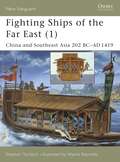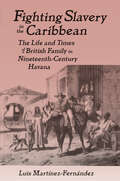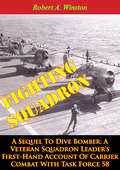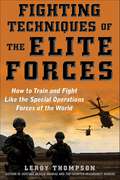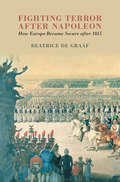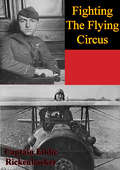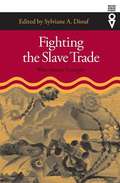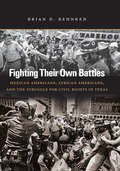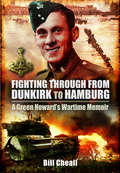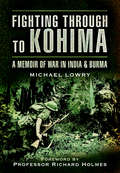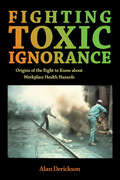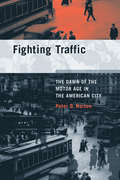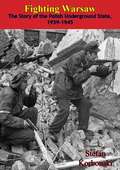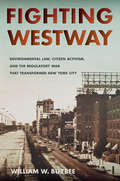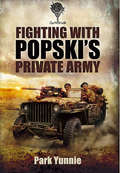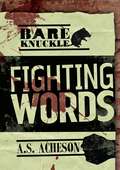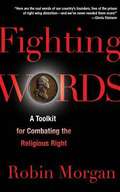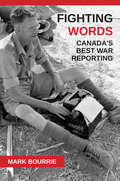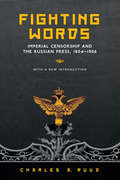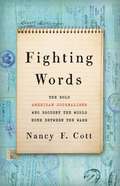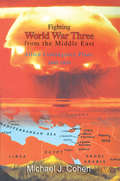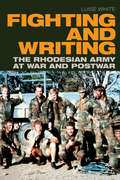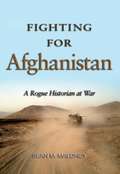- Table View
- List View
Fighting Ships of the Far East
by Stephen Turnbull Wayne ReynoldsFighting Ships of the Far East (1) adds enormously to the hitherto small corpus of knowledge about a fascinating and little known subject. Using detailed descriptions, accurate cutaway plates and reliable historical examples, this book covers the history of Chinese ship design and naval warfare from the beginning of the Han dynasty to the first few years of the Ming dynasty. The epic battle of Lake Poyang in in 1363, won by the man who was to become the first Ming Emperor, is also detailed.
Fighting Slavery in the Caribbean: Life and Times of a British Family in Nineteenth Century Havana
by Luis Martinez-FernandezThis volume presents a social history of life in mid-19th-century Cuba as experienced by George Backhouse (and his wife, Grace), who served on the British Havana Mixed Commission for the Suppression of the Slave Trade. Documented with extracts from the Backhouse's correspondence, diaries and other contemporary papers, Martinez-Fernandez paints a detailed picture of the Cuban slave trade, its role in the sugar industry, and the interrelated contradictions within Cuba's economy, society and politics. The Backhouse story provides addition al insights into important aspects of life in the "male" city of Havana, social antagonisms between Britons and North Americans, interactions with European social circles, religious tension, and the reality of tropical disease. Drama is added to the narrative in the author's description of the tragic and mysterious murder of George Backhouse in August 1855, possibly the result of a slave traders' conspiracy.
Fighting Squadron, A Sequel To Dive Bomber: A Veteran Squadron Leader’s First-Hand Account Of Carrier Combat With Task Force 58
by Lt.-Cmdr. Robert A. WinstonAn engaging memoir of Lieutenant-Commander Robert A. Winston's wartime experiences as squadron leader of Fighting Squadron 31, which succeeded in shooting down more enemy aircraft than any other squadron serving on light carriers then in action.Robert A. Winston was born in Washington, Indiana, in 1907 and graduated from Indiana University. He worked for The New York Times and The New York News for five years before starting flight training with the navy in 1935. He flew in fighting squadrons on both coasts and as an instructor at Pensacola, and he wrote about his initial aviation training in Dive Bomber, published in 1939 when Winston held the rank of lieutenant. In his second book, Aces Wild, he chronicled his experiences in Europe during 1939-40 as a test pilot accompanying a consignment of fighters destined for Finland. Back on active duty in the United States, he served as a flight instructor, then in the public relations office in Washington, D.C. After the attack on Pearl Harbor he was assigned to combat duty in the Pacific, which he recounts in Fighting Squadron, published in 1946 when Winston was a commander. At the end of the war he was serving on Admiral Nimitz's staff on Guam. From there he moved to Stockholm, where he served as the naval air attaché.
Fighting Techniques of the Elite Forces: How to Train and Fight Like the Special Operations Forces of the World
by Leroy ThompsonLearn the trade secrets of special operatives. It is easy to visualize special operations troops as men in camouflage with painted faces, lurking in the shadows of modern warfare. But the truth is far more complex—and enthralling. A wide array of skills, both physical and cerebral, combines to make up the modern elite soldier. Fighting Techniques of the Elite Forces not only shows the road down which the specialist must travel to reach his place as one of the world's fighting elite, it details the equipment he uses to carry out his missions and the actual techniques he employs. Themed chapters and a wealth of illustrations explain everything you need to know about the formidably trained warriors of the British and Australian SAS, US Army Rangers, Navy SEALs, the French GIGN, and more. Learn how to select a drop zone for parachute insertions or how to execute a High Altitude High Opening (HAHO) insertion when you are twenty miles' distance from your objective. Find out how combat swimmers launch from submarines to carry out beach reconnaissance prior to an invasion. Understand the special considerations and knowledge required to fight and, more importantly, survive in such hostile environments as jungle, desert, or mountain. Discover how today's special operative must master skills as diverse as horsemanship and the compact computer, or how to kill silently with a knife or laser designator.Fighting Techniques of the Elite Forces is a must-have for anyone interested in the covert world of elite forces; it will provide the key to understanding what makes the specialist soldier so very "special."
Fighting Terror after Napoleon: How Europe Became Secure after 1815
by Beatrice de GraafAfter twenty-six years of unprecedented revolutionary upheavals and endless fighting, the victorious powers craved stability after Napoleon's defeat in 1815. With the threat of war and revolutionary terror still looming large, the coalition launched an unprecedented experiment to re-establish European security. With over one million troops remaining in France, they established the Allied Council to mitigate the threat of war and terror and to design and consolidate a system of deterrence. The Council transformed the norm of interstate relations into the first, modern system of collective security in Europe. Drawing on the records of the Council and the correspondence of key figures such as Metternich, Castlereagh, Wellington and Alexander I, Beatrice de Graaf tells the story of Europe's transition from concluding a war to consolidating a new order. She reveals how, long before commercial interest and economic considerations on scale and productivity dictated and inspired the project of European integration, the common denominator behind this first impulse for a unification of Europe in norms and institutions was the collective fight against terror.
Fighting The Flying Circus [Illustrated Edition]
by Captain Eddie RickenbackerIncludes Aerial Warfare During World War I Illustrations Pack with 115 maps, plans, and photos.Captain Rickenbacker, originally from Ohio, was best known as one of the Commanders of the 94th "Hat-in-the-Ring" Squadron, a crack unit of pilots which included many former members of the famed Lafayette Escadrille. The 94th ended the war in France with the highest number of air victories of any American squadron. Captain Rickenbacker himself was credited with 26 aerial victories all within the last six months of the war, he was decorated with the Congressional Medal Of Honor for his inspirational leadership and fearless flying.
Fighting The Slave Trade: West African Strategies
by Sylviane A. DioufWhile most studies of the slave trade focus on the volume of captives and on their ethnic origins, the question of how the Africans organized their familial and communal lives to resist and assail it has not received adequate attention. But our picture of the slave trade is incomplete without an examination of the ways in which men and women responded to the threat and reality of enslavement and deportation. <P><P>Fighting the Slave Trade is the first book to explore in a systematic manner the strategies Africans used to protect and defend themselves and their communities from the onslaught of the Atlantic slave trade and how they assaulted it. <P>It challenges widely held myths of African passivity and general complicity in the trade and shows that resistance to enslavement and to involvement in the slave trade was much more pervasive than has been acknowledged by the orthodox interpretation of historical literature. <P>Focused on West Africa, the essays collected here examine in detail the defensive, protective, and offensive strategies of individuals, families, communities, and states. In chapters discussing the manipulation of the environment, resettlement, the redemption of captives, the transformation of social relations, political centralization, marronage, violent assaults on ships and ports, shipboard revolts, and controlled participation in the slave trade as a way to procure the means to attack it, Fighting the Slave Trade presents a much more complete picture of the West African slave trade than has previously been available.
Fighting Their Own Battles: Mexican Americans, African Americans, and the Struggle for Civil Rights in Texas
by Brian D. BehnkenBetween 1940 and 1975, Mexican Americans and African Americans in Texas fought a number of battles in court, at the ballot box, in schools, and on the streets to eliminate segregation and state-imposed racism. Although both groups engaged in civil rights struggles as victims of similar forms of racism and discrimination, they were rarely unified. In Fighting Their Own Battles, Brian Behnken explores the cultural dissimilarities, geographical distance, class tensions, and organizational differences that all worked to separate Mexican Americans and blacks. Behnken further demonstrates that prejudices on both sides undermined the potential for a united civil rights campaign. Coalition building and cooperative civil rights efforts foundered on the rocks of perceived difference, competition, distrust, and, oftentimes, outright racism. Behnken's in-depth study reveals the major issues of contention for the two groups, their different strategies to win rights, and significant thematic developments within the two civil rights struggles. By comparing the histories of these movements in one of the few states in the nation to witness two civil rights movements, Behnken bridges the fields of Mexican American and African American history, revealing the myriad causes that ultimately led these groups to "fight their own battles. "
Fighting Through from Dunkirk to Hamburg: A Green Howard's Wartime Memoir
by Bill CheallA British infantryman shares his harrowing story of life on the frontlines of WWII, from the North African Campaign to the invasion of Germany. In April 1939, when Bill Cheall joined the famous Yorkshire infantry regiment known as the Green Howards, he could not have imagined the drama, trauma, rewards and anguish that awaited him. But he recounts it all here, in this vivid memoir of service and courage under fire. As a Green Howard, Cheall was on the receiving end of the Nazis' Blitzkrieg and was evacuated exhausted. Then, courtesy of the Queen Mary, he shipped off to North Africa as part of Field Marshal Bernard Montgomery's Eight Army. After their victory in Tunisia, Cheall went on to the invasion of Sicily. The Green Howards then returned to England to be in the vanguard of the Normandy Landings on Gold Beach—where Cheall was wounded. Once he recovered, Cheall returned to the war zone and finished the war as a Regimental Policeman in occupied Germany. It is a remarkable story told with modesty, humor, and an eye for detail.
Fighting Through to Hitler's Germany: Personal Accounts of the Men of 1 Suffolk 1944–45
by Mark Forsdike&“The real story of how the Second World war was won in Europe . . . Packed with the personal stories of the men who were there.&” —Clash of Steel After landing on D-Day, 1st Battalion, The Suffolk Regiment fought through France, Holland and into Germany as part of the 3rd (British) Infantry Division. Ever cheerful, the Battalion were opposed by an increasingly ruthless enemy determined to deny the invader their homeland. As the campaign developed, 1 Suffolk acquired an enviable reputation for getting the job done with the minimum of fuss. Inevitably casualties mounted up and, of the 850 who landed on D-Day, just 178 were still serving on VE-Day; 215 had been killed and 640 wounded. The Battalion&’s success was due in large measure to fine leadership and all four commanding officers went on to enjoy distinguished careers. But without the stalwart fighting spirit and comradeship of all ranks none of the Battalion&’s achievements would have been possible. This fine book draws on the testimonies of officers and men who served in this historic campaign. Recognition of the fighting record of 1 Suffolk is long overdue and the author is to be congratulated for pulling together these inspiring first-hand accounts along with many previously unpublished photographs.A Soldier Magazine Top Read of the Year&“Brings life to the story of in this case World War II, and gives an insight into what this war was like. The author deserves praise for the way he has presented the words of these men, as it makes for a very engaging read.&” —Armorama
Fighting Through to Kohima: A Memoir of War in India and Burma
by Michael LowryA decorated British officer&’s wrenching and inspiring firsthand account of the worst battle of the Burma campaign. Lt. Col. Michael Lowry MC MBE, was awarded the Military Cross for his role in the desperate defensive action at Kohima, considered the worst of the campaign in Burma. After joining up in 1939 with the Queen&’s Royal Regiment, Lowry was posted to the North West Frontier of India, where he cut his teeth chasing gangs of Pathan bandits for two years. As the Japanese advanced into Burma, Lowry found himself fighting in the Arakan region, where his battalion was cut off by the Japanese for three weeks. Having survived that, next came the action at Kohima—where in the course of one week Lowry&’s battalion lost 173 members. Lowry was seriously wounded in the conflict but fortunately lived to tell the tale. This is a fascinating and inspiring book, one of the most action-packed memoirs of the war in Burma ever published.
Fighting Toxic Ignorance: Origins of the Right to Know about Workplace Health Hazards
by Alan DericksonFighting Toxic Ignorance explores conflict over access to information regarding health hazards encountered in the US workplace during the first three-quarters of the twentieth century. Alan Derickson considers risks posed by toxic chemicals and physical and biological agents of disease. By the 1970s, occupational disease was estimated to kill up to 100,000 Americans a year. Derickson unravels the social and political forces and the conflictual process that gave rise to a sustained social movement for a workers' right to know about often-insidious threats. He argues that the decades prior to the emergence of this movement were not a dark age of victimization brought about by enforced ignorance but a time of recurrent battles over the disclosure of needed facts. Workplace warnings—informative signs, labels, and instructions—often saved lives. Fighting Toxic Ignorance covers a broad range of dangerous substances, deals with a large share of the national workforce, and illuminates the many ways that activists endeavored to see that warnings reached workers, especially immigrants and workers of color.
Fighting Traffic: The Dawn of the Motor Age in the American City (Inside Technology)
by Peter D. NortonThe fight for the future of the city street between pedestrians, street railways, and promoters of the automobile between 1915 and 1930.Before the advent of the automobile, users of city streets were diverse and included children at play and pedestrians at large. By 1930, most streets were primarily a motor thoroughfares where children did not belong and where pedestrians were condemned as “jaywalkers.” In Fighting Traffic, Peter Norton argues that to accommodate automobiles, the American city required not only a physical change but also a social one: before the city could be reconstructed for the sake of motorists, its streets had to be socially reconstructed as places where motorists belonged. It was not an evolution, he writes, but a bloody and sometimes violent revolution. Norton describes how street users struggled to define and redefine what streets were for. He examines developments in the crucial transitional years from the 1910s to the 1930s, uncovering a broad anti-automobile campaign that reviled motorists as “road hogs” or “speed demons” and cars as “juggernauts” or “death cars.” He considers the perspectives of all users—pedestrians, police (who had to become “traffic cops”), street railways, downtown businesses, traffic engineers (who often saw cars as the problem, not the solution), and automobile promoters. He finds that pedestrians and parents campaigned in moral terms, fighting for “justice.” Cities and downtown businesses tried to regulate traffic in the name of “efficiency.” Automotive interest groups, meanwhile, legitimized their claim to the streets by invoking “freedom”—a rhetorical stance of particular power in the United States. Fighting Traffic offers a new look at both the origins of the automotive city in America and how social groups shape technological change.
Fighting Warsaw: The Story Of The Polish Underground State, 1939-1945
by Stefan Korbonski F. B. CzarnomskiFighting Warsaw is a human story. Stefan Korbonski, the leader of the Polish Underground State, portrays the years of the German occupation during the Second World War and the beginning of anti-Soviet underground activities thereafter. His story presents the entire organization, strategy, and tactics of the Polish underground, which included armed resistance, civil disobedience, sabotage, and boycotts. "...The Polish Underground was perhaps the best organized and most active of all wartime undergrounds; and Stefan Korbonski is well qualified to tell its story....He was, almost immediately after the fighting had stopped, arrested by the Russians...he managed to regain his freedom, and it is to this happy release that we owe this book, an absorbing account of Poland's fight for freedom These are the highly personal memoirs of an active conspirator and, in their vivid detail and exciting anecdotes, they are probably more successful in conveying a sense of what the resistance was actually like than a more comprehensive treatment would be...Few people who read the author's chapters on this one aspect of the resistance will fail to be moved by them or to come away from them with an increased understanding of the prerequisites of successful opposition to an occupying power that is both efficient and ruthless."--GORDON CRAIG, New York Herald Tribune"...Fighting Warsaw...is one of the most absorbing, inspiring and ultimately disheartening documents to come out of the last war....The book, which is detailed and written with humor, modesty, and a surprising lack of rancor, makes it quite plain that there is an indomitable quality in the Poles that will prevent them from ever giving up their great dream...."--The New Yorker
Fighting Westway: Environmental Law, Citizen Activism, and the Regulatory War That Transformed New York City
by William W. BuzbeeFrom 1971 to 1985, battles raged over Westway, a multibillion-dollar highway, development, and park project slated for placement in New York City. It would have projected far into the Hudson River, including massive new landfill extending several miles along Manhattan's Lower West Side. The most expensive highway project ever proposed, Westway also provoked one of the highest stakes legal battles of its day. In Fighting Westway, William W. Buzbee reveals how environmentalists, citizens, their lawyers, and a growing opposition coalition, despite enormous resource disparities, were able to defeat this project supported by presidents, senators, governors, and mayors, much of the business community, and most unions. Although Westway's defeat has been derided as lacking justification, Westway's critics raised substantial and ultimately decisive objections. They questioned claimed project benefits and advocated trading federal Westway dollars for mass transit improvements. They also exposed illegally disregarded environmental risks, especially to increasingly scarce East Coast young striped bass often found in extraordinarily high numbers right where Westway was to be built.Drawing on archival records and interviews, Buzbee goes beyond the veneer of government actions and court rulings to illuminate the stakes, political pressures, and strategic moves and countermoves that shaped the Westway war, a fight involving all levels and branches of government, scientific conflict, strategic citizen action, and hearings, trials, and appeals in federal court. This Westway history illuminates how high-stakes regulatory battles are fought, the strategies and power of America's environmental laws, ways urban priorities are contested, the clout of savvy citizen activists and effective lawyers, and how separation of powers and federalism frameworks structure legal and political conflict. Whether readers seek an exciting tale of environmental, political, and legal conflict, to learn what really happened during these battles that transformed New York City, or to understand how modern legal frameworks shape high stakes regulatory wars, Fighting Westway will provide a good read.
Fighting With Popski’s Private Army
by Park YunnieThis is the story of Popskis famous fighting unit, in the words of his second-in-command.Captain Bob Yunnie, MC, aka Park Yunnie, became the first recruit to the special unit founded in Cairo by Major Vladimir Peniakoff (Popski). As the Eighth Army advances towards Tripoli, PPA sets out in jeeps across the desert to mount raids behind the Mareth Line. Yunnie relives the ensuing action at Gafsa and Kasserine, and vividly depicts the sorties which took the men straight across the German Line of Command.As Tunis falls to the Allies on 7 May 1943, PPA train for raids on the Italian mainland. They are dropped by RAF gliders in central Italy, where they set about blowing up strategic targets while waiting for the Allied landings. Yunnie is given his own patrol, and in the narrative that follows, colorful characters flit in and out of the front-line action in the mountains of Southern Italy.Yunnies account is an honest, extremely personal, expos of the thrills and occasional pitfalls of life with Popski and his men.
Fighting Words (Bareknuckle)
by A. S. AchesonMyles McReary is trying to save up enough money to bring his family over from Ireland. And he's doing it the only way he knows: through bareknuckle boxing. Myles is one of the toughest young fighters at the Bowery's Woodrat Club. Even so, when the Woodrat arranges a match between Myles and Giancarlo Sperio, the best boxer in Harlem, Myles worries he's met his match. Myles knows he can't back down. If he does, he'll fail his family. So he turns to Father O'Carroll, a mysterious neighborhood priest. But Father O'Carroll's solution gives Will a whole new set of problems…
Fighting Words and Images
by Elena V. Baraban Adam Muller Stephan JaegerFighting Words and Images is the first comprehensive interdisciplinary and theoretical analysis of war representations across time periods from Classical Antiquity to the present day and across languages, cultures, and media including print, painting, sculpture, architecture, and photography.Featuring contributions from across the humanities and social sciences, Fighting Words and Images is organized into four thematically consistent, analytically rigourous sections that discuss ways to overcome the conceptual challenges associated with theorizing war representation. This collection creatively and insightfully explains the nature, origins, dynamics, structure, and impact of a wide variety of war representations.
Fighting Words: A Toolkit for Combating the Religious Right
by Robin MorganThe Religious Right is gaining enormous power in the United States, thanks to a well-organized, media-savvy movement with powerful friends in high places. Yet many Americans -- both observant and secular -- are alarmed by this trend, especially by the Religious Right's attempts to erase the boundary between church and state and re-make the U.S. into a Christian nation. But most Americans lack the tools for arguing with the Religious Right, especially when fundamentalist conservatives claim their tradition started with the framers of the Constitution. "Fighting Words" is a tool-kit for arguing, especially for those of us who haven't read the founding documents of this nation since grad school. Robin Morgan has assembled a lively, accessible, eye-opening primer and reference tool, a "verbal karate" guide, revealing what the Framers and many other leading Americans really believed -- in their own words -- rescuing the Founders from images of dusty, pompous old men in powdered wigs, and resurrecting them as the revolutionaries they truly were: a hodgepodge of freethinkers, Deists, agnostics, Christians, atheists, and Freemasons -- and they were radicals as well.
Fighting Words: Canada's Best War Reporting
by Mark BourrieA collection of the best journalism from Canada’s wars, from the time of the Vikings to the war in Afghanistan. Fighting Words is a collection of the very best war journalism created by or about Canadians at war. The collection spans 1,000 years of history, from the Vikings’ fight with North American Natives, through New France’s struggle for survival against the Iroquois and British, to the American Revolution, the War of 1812, the Rebellions of Lower and Upper Canada, the Fenian raids, the North-West Rebellion, the First World War, the Second World War, Korea, peacekeeping missions, and Afghanistan. Each piece has an introduction describing the limits placed on the writers, their apparent biases, and, in many cases, the uses of the article as propaganda. The stories were chosen for their impact on the audience they were written for, their staying power, and, above all, the quality of their writing.
Fighting Words: Imperial Censorship and the Russian Press, 1804–1906
by Charles A RuudCensorship took many forms in Imperial Russia. First published in 1982, Fighting Words focuses on the most common form: the governmental system that screened written works before or after publication to determine their acceptability. Charles A. Ruud shows that, despite this system, the nineteenth-century Russian Imperial government came to grant far more extensive legal publishing freedoms than most Westerners realize, adopting a more liberal attitude towards the press by permitting it a position recognized by law. Fighting Words also reveals, however, that the government fell far short of implementing these reforms, thus contributing to the growth of opposition to the Tsarist regime in the second half of the nineteenth century and the first few years of the twentieth. Now back in print with a new introduction by the author, Fighting Words is a classic work offering insight into the press, censorship, and the limits of printed expression in Imperial Russia.
Fighting Words: The Bold American Journalists Who Brought the World Home Between the Wars
by Nancy F. CottFrom a Harvard historian, this riveting portrait of four trailblazing American journalists highlights the power of the press in the interwar period. In the fragile peace following the Great War, a surprising number of restless young Americans abandoned their homes and set out impulsively to see the changing world. In Fighting Words, Nancy F. Cott follows four who pursued global news -- from contested Palestine to revolutionary China, from Stalin's Moscow to Hitler's Berlin. As foreign correspondents, they became players in international politics and shaped Americans' awareness of critical interwar crises, the spreading menace of European fascism, and the likelihood of a new war -- while living romantic and sexual lives as modern and as hazardous as their journalism. An indelible portrayal of a tumultuous era with resonance for our own, Fighting Words is essential reading on the power of the press and the growth of an American sense of international responsibility.
Fighting World War Three from the Middle East: Allied Contingency Plans, 1945-1954
by Michael J. CohenThis description of Allied contingency plans for military operations in the Middle East - in the event of conflict with the Soviet Union - argues that diplomatic events and crises in the Middle East in 1945-55 are understandable only in the context of assets sought by the Allies in that region.
Fighting and Writing: The Rhodesian Army at War and Postwar
by Luise WhiteIn Fighting and Writing Luise White brings the force of her historical insight to bear on the many war memoirs published by white soldiers who fought for Rhodesia during the 1964–1979 Zimbabwean liberation struggle. In the memoirs of white soldiers fighting to defend white minority rule in Africa long after other countries were independent, White finds a robust and contentious conversation about race, difference, and the war itself. These are writings by men who were ambivalent conscripts, generally aware of the futility of their fight—not brutal pawns flawlessly executing the orders and parroting the rhetoric of a racist regime. Moreover, most of these men insisted that the most important aspects of fighting a guerrilla war—tracking and hunting, knowledge of the land and of the ways of African society—were learned from Black playmates in idealized rural childhoods. In these memoirs, African guerrillas never lost their association with the wild, even as white soldiers boasted of bringing Africans into the intimate spaces of regiment and regime.
Fighting for Afghanistan
by Sean M. MaloneySean Maloney, the first Canadian military historian to go into battle since the Korean War, brings the intensity of near-fatal experiences in southern Afghanistan to his description of events in 2006 when the Taliban insurgency threatened to overwhelm the U.S.-led coalition. He explains how the shift from small-scale guerilla attacks and urban terrorism to near-conventional warfare caught everyone by surprise and forced a small, under-equipped Canadian battle group into a desperate series of battles that ultimately saved Kandahar City. Maloney tells exactly what happened at all levels, from infantry company to battle group to brigade headquarters. He is the first to provide such details and give historical context, while helping readers understand the difficulties involved in complex coalition operations.
